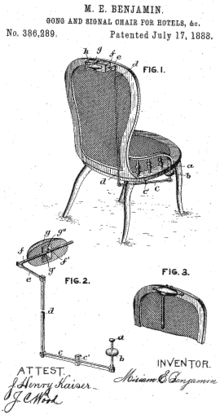Miriam Benjamin
Miriam E. Benjamin (September 16, 1861 – 1947) was an American school teacher and inventor. On July 17,[1] 1888 she obtained a patent for her invention, the Gong and Signal Chair for Hotels. As its name suggests, the chair had both a gong and signal connected to it.[2] The chair would "reduce the expenses of hotels by decreasing the number of waiters and attendants, to add to the convenience and comfort of guests and to obviate the necessity of hand clapping or calling aloud to obtain the services of pages." The chair worked when the person sitting would press a small button on the back of the chair which would then send a signal to a waiting attendant. A light would illuminate as well, allowing the attendant to see which guest needed help. The system was eventually adopted by the United States House of Representatives and was a precursor to the signaling system used on airplanes for passengers to seek assistance from flight attendants.[3]
Miriam E. Benjamin | |
|---|---|
 The patent used by Benjamin for the Gong and Signal Chair for Hotels. | |
| Born | Miriam E. Benjamin September 16, 1861 |
| Died | 1947 Boston, Massachusetts |
| Nationality | American |
| Occupation | Inventor Educator |
| Known for | Inventor of the Gong and Signal Chair and second black woman to receive a patent in the United States |
Career
Upon her move to Washington, D.C., Benjamin became a teacher in the segregated municipal school system. In 1888, she was living at 1736 New York Avenue, N.W. in Washington.[4]
Miriam Benjamin briefly attended Howard University's medical school,[5] but after passing a competitive civil service examination and working as a government clerk in a number of federal departments,[6] she enrolled in the law school at Howard University. Upon graduation, she set herself up in business as a "solicitor of patents."
Miriam Benjamin's career as an inventor did not end with her Gong and Signal chair. On December 4, 1917, she received U.S. patent no. 1,249,000 for her Sole for Footwear. This invention was intended to help with temperature regulation in the foot.[7]
Music historians believe she, under the gender-neutral pseudonym E.B. Miriam, also composed marches. One of these was used by Theodore Roosevelt's presidential campaign in 1904.[8]
In 1920, she returned to Boston, where she lived and worked with her brother, attorney Edgar P. Benjamin.[9] Along with Sarah Boone, Ellen Eglin, and Sarah E. Goode, Benjamin was one of four African American women inventors of her time who developed new technology for the home.[10]
She died in 1947.[11]
Personal life
Miriam Benjamin was born in Charleston, South Carolina in 1861[12] as a free black woman. She was the eldest of five children of Francis Benjamin and Eliza (Hopkins) Benjamin.[13] In 1873, the Benjamin family moved to Boston, Massachusetts,[14] where Miriam attended high school.
Her sisters were Charlotte D. "Lottie" Benjamin (1863–1928, m. Walter W. Sampson, 1889, no children) and Eva S. Benjamin (1867–73).[15] Her brother Lyde Wilson Benjamin (1865–1916) was an attorney as well as an inventor. On May 16, 1893, he received U.S. patent no. 497,747 for an improvement on "Broom Moisteners and Bridles." Her younger brother Edgar Pinkerton Benjamin (1869–1972) graduated from Boston University's law school and had a successful private practice in the city of Boston.[16] Although best remembered for establishing the Resthaven Nursing Home (now the Benjamin Healthcare Center) in Roxbury, Massachusetts, he also received U.S. patent no. 475,749 for a "Trousers-Shield," or, a bicycle clip, on May 31, 1892.
Miriam Benjamin never married. For most of her life she lived with her widowed mother Eliza Jane (Hopkins) Benjamin (1840–1934) in the Boston area.[17]
References
- Mary Bellis (2011). "Miriam Benjamin". Inventors. About.com. Retrieved 13 November 2011.
- Merritt, Deborah J. “Hypatia in the Patent Office: Women Inventors and the Law, 1865-1900.” The American Journal of Legal History, vol. 35, no. 3, 1991, pp. 235–306. JSTOR, www.jstor.org/stable/845974. Accessed 30 Apr. 2020.
- "Miriam Benjamin". Inventors. The Black Inventor On-Line Museum. 2011. Archived from the original on 2 November 2011. Retrieved 13 November 2011.
- Boyd's Directory of the District of Columbia(Washington, 1888), 208
- Lamb, 235
- Boyd's Directory of the District of Columbia (Washington, 1891), 212
- Benjamin, Miriam E. "Sole for footwear." U.S. Patent No. 1,249,000. 4 Dec. 1917.
- Eleanor Mahoney (2019). "Miriam E. Benjamin (1861-1947)". BlackPast.org. blackpast.org. Retrieved 17 July 2019.
- 1930 Federal Census for Suffolk County Enumeration District 13-319, Sheet 15-A, Lines 24–26 (50 Fernwood Road, Boston, Mass.)
- McNeill, Leila (7 February 2017). "These Four Black Women Inventors Reimagined the Technology of the Home". Smithsonian. Retrieved 6 February 2018.
- Massachusetts Deaths for 1947 6:63; Department of Public Health, Registry of Vital Records and Statistics. Massachusetts Vital Records Index to Deaths [1916–1970]. Volumes 66–145. Facsimile edition. Boston, MA: New England Historic Genealogical Society, Boston, Massachusetts.
- Daniel Smith Lamsity Medical Department (Washington, D.C., 1900), 235
- Although she would consistently cite 1868 as her birthda 2nd Ward of the city of Charleston, Charleston County, South Carolina, page 117, lines 17–25 (misspelling her name as Marianna)
- 1880 Federal Census for Suffolk County (Massachusetts) Enumeration District 703, Sheet 14, Lines 42–45 (10 Dover Street, Boston, Mass. [1st Precinct of the 16th Ward])
- Massachusetts Deaths 258:7. Massachusetts State Archives, Columbia Point, Boston, Mass.
- Anthony W. Neal, "Edgar P. Benjamin: Philanthropist, Noted Attorney and Banker," Bay State Banner, March 28, 2013, cited at http://baystatebanner.com/news/2013/mar/28/edgar-p-benjamin-philanthropist-noted-attorney-and/ Accessed September 10, 2013. He always used the date 1871 as his birthdate; however the 1870 Federal Census return cited above shows him as a six-month-old infant born the previous December.
- 1930 Federal Census